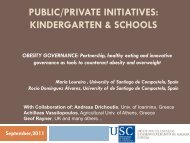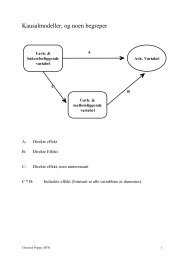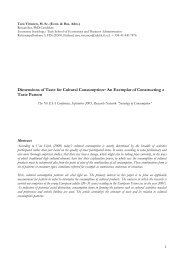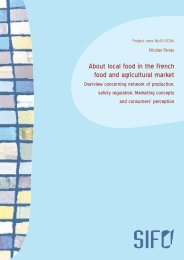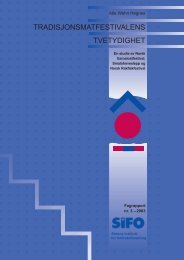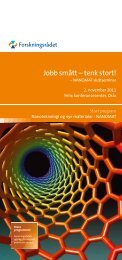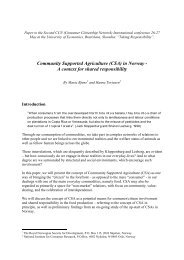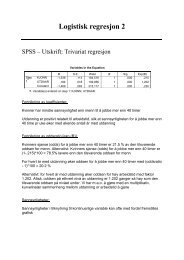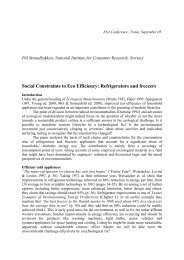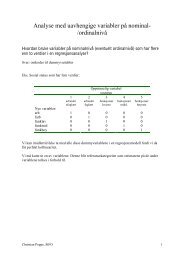an investigation of domestic laundry in europe - habits ... - SIFO
an investigation of domestic laundry in europe - habits ... - SIFO
an investigation of domestic laundry in europe - habits ... - SIFO
You also want an ePaper? Increase the reach of your titles
YUMPU automatically turns print PDFs into web optimized ePapers that Google loves.
Hygiene effects <strong>of</strong> <strong>laundry</strong> processes <strong>in</strong> Europe 714.2 Research design4.2.1 BackgroundThe hygiene effects <strong>of</strong> different <strong>laundry</strong> processes <strong>in</strong> Europe (Greece, Norway,Spa<strong>in</strong> <strong>an</strong>d the Netherl<strong>an</strong>ds) will be assessed <strong>in</strong> this research. The focus ison the hygienic quality <strong>of</strong> wash<strong>in</strong>g processes at low temperatures (i.e. 15°C<strong>an</strong>d 30°C) <strong>an</strong>d on the two most common wash<strong>in</strong>g processes <strong>in</strong> each country <strong>of</strong><strong>in</strong>terest.Block et al. [5] recently developed a test method to determ<strong>in</strong>e the micriobicidaleffect <strong>of</strong> <strong>laundry</strong> detergents with<strong>in</strong> a wash<strong>in</strong>g process. In this test, artificiallycontam<strong>in</strong>ated micro-org<strong>an</strong>ism carriers are washed together with sterileballast fabrics <strong>in</strong> a normal wash<strong>in</strong>g mach<strong>in</strong>e under realistic conditions. After acomplete wash<strong>in</strong>g cycle, the surviv<strong>in</strong>g test org<strong>an</strong>isms on the carriers are identified,<strong>an</strong>d cross-contam<strong>in</strong>ation <strong>an</strong>d contam<strong>in</strong>ation <strong>of</strong> the wash<strong>in</strong>g liquid areevaluated as well. Block states that this test method is suitable for simulat<strong>in</strong>grealistic household <strong>laundry</strong> conditions <strong>an</strong>d uses relev<strong>an</strong>t test org<strong>an</strong>isms.The Block method uses artificially contam<strong>in</strong>ated micro-org<strong>an</strong>ism carriers withhigh contam<strong>in</strong>ation levels. These high contam<strong>in</strong>ation levels allow for the calculation<strong>of</strong> viable reduction factors. The test org<strong>an</strong>isms used are very specific<strong>an</strong>d are selected with regard to their relev<strong>an</strong>ce to household conditions <strong>an</strong>d onthe basis <strong>of</strong> exist<strong>in</strong>g proposals.The objective <strong>of</strong> the present study, however, is to assess the hygiene effect <strong>of</strong>a wash<strong>in</strong>g process <strong>an</strong>d not solely to determ<strong>in</strong>e the micriobicidal effect <strong>of</strong> the<strong>laundry</strong> detergent. The fixation <strong>an</strong>d aggregation <strong>of</strong> micro-org<strong>an</strong>isms to soilparticles <strong>in</strong> real life situations is quite different from the artificial contam<strong>in</strong>ationused by Block. Therefore, <strong>an</strong>d from <strong>an</strong> even more realistic po<strong>in</strong>t <strong>of</strong> view,it is <strong>in</strong>terest<strong>in</strong>g to <strong>in</strong>vestigate the reduction (or cross-contam<strong>in</strong>ation) <strong>of</strong> microorg<strong>an</strong>ismson naturally soiled <strong>domestic</strong> <strong>laundry</strong>.The start<strong>in</strong>g po<strong>in</strong>t <strong>of</strong> this research design is the Block method with some majormodifications. The microbiological count <strong>of</strong> relev<strong>an</strong>t micro-org<strong>an</strong>isms onnaturally soiled <strong>domestic</strong> <strong>laundry</strong> items will be determ<strong>in</strong>ed <strong>in</strong> a laboratory testbefore <strong>an</strong>d after wash<strong>in</strong>g. The wash load is filled with a sterile cotton baseload as <strong>in</strong> the Block method. The micro-org<strong>an</strong>isms <strong>an</strong>d <strong>laundry</strong> items are selectedon the basis <strong>of</strong> a literature study <strong>an</strong>d from laboratory tests. Furthermore,cross-contam<strong>in</strong>ation <strong>of</strong> <strong>laundry</strong> items is determ<strong>in</strong>ed by wash<strong>in</strong>g sterile pieces



